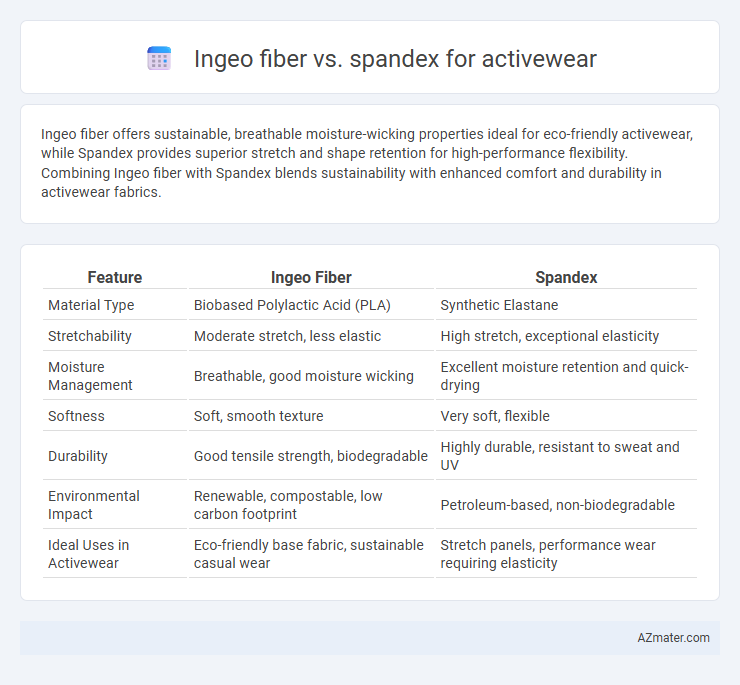Ingeo fiber offers sustainable, breathable moisture-wicking properties ideal for eco-friendly activewear, while Spandex provides superior stretch and shape retention for high-performance flexibility. Combining Ingeo fiber with Spandex blends sustainability with enhanced comfort and durability in activewear fabrics.
Table of Comparison
| Feature | Ingeo Fiber | Spandex |
|---|---|---|
| Material Type | Biobased Polylactic Acid (PLA) | Synthetic Elastane |
| Stretchability | Moderate stretch, less elastic | High stretch, exceptional elasticity |
| Moisture Management | Breathable, good moisture wicking | Excellent moisture retention and quick-drying |
| Softness | Soft, smooth texture | Very soft, flexible |
| Durability | Good tensile strength, biodegradable | Highly durable, resistant to sweat and UV |
| Environmental Impact | Renewable, compostable, low carbon footprint | Petroleum-based, non-biodegradable |
| Ideal Uses in Activewear | Eco-friendly base fabric, sustainable casual wear | Stretch panels, performance wear requiring elasticity |
Introduction to Ingeo Fiber and Spandex
Ingeo fiber, derived from renewable plant-based resources like corn, offers sustainable moisture-wicking and breathability properties ideal for activewear, distinguishing it from synthetic alternatives. Spandex, known for its exceptional elasticity and recovery, provides superior stretch and comfort, making it a staple in performance garments requiring flexibility. Both fibers address different performance needs, with Ingeo emphasizing eco-friendly moisture management and Spandex delivering unrestricted movement.
Key Properties of Ingeo Fiber
Ingeo fiber, derived from renewable plant-based resources, offers exceptional breathability and moisture-wicking capabilities, making it ideal for activewear that demands comfort and dry performance. Its natural biodegradability and low environmental impact provide a sustainable alternative to synthetic fibers like spandex, which is primarily valued for its superior elasticity and stretch recovery. Ingeo fiber's thermal regulation and softness enhance wearer comfort during intense physical activities, while spandex contributes primarily to garment flexibility and shape retention.
Essential Characteristics of Spandex
Spandex fibers are renowned for exceptional elasticity, offering up to 500% stretch and rapid recovery, which ensures superior flexibility and shape retention in activewear. Their lightweight, moisture-wicking, and breathable properties contribute to enhanced comfort and performance during physical activities. Unlike Ingeo fiber, which is biodegradable and made from renewable resources, Spandex's durability and elasticity remain unmatched for intense, dynamic movements in sportswear applications.
Moisture Management and Breathability
Ingeo fiber offers superior moisture-wicking properties by efficiently drawing sweat away from the skin, promoting faster evaporation and enhanced comfort during intense workouts. Spandex, known for its exceptional stretch and shape retention, provides moderate breathability but tends to trap moisture, making it less effective in maintaining dryness. Combining Ingeo fiber with Spandex in activewear optimizes both moisture management and breathability, delivering a balanced performance fabric for active lifestyles.
Comfort and Fit in Activewear
Ingeo fiber, derived from renewable plant-based materials, offers superior breathability and moisture-wicking properties compared to traditional spandex, enhancing comfort during intense workouts. Spandex provides exceptional stretch and recovery, ensuring a snug fit and freedom of movement crucial for activewear performance. Combining Ingeo fiber with spandex creates a balanced fabric blend that maximizes both comfort and fit, ideal for sustainable and high-performance athletic apparel.
Durability and Performance Comparison
Ingeo fiber, made from renewable plant-based materials, offers excellent breathability and moisture-wicking properties ideal for activewear, while maintaining moderate durability against wear and tear. Spandex, known for its exceptional elasticity and resilience, provides superior stretch and recovery, ensuring sustained performance during intense physical activity. Combining Ingeo fiber with Spandex enhances overall garment durability and flexibility, optimizing comfort and long-term wear performance for activewear applications.
Sustainability: Ingeo vs Spandex
Ingeo fiber, derived from renewable plant-based materials like corn starch, offers a biodegradable and low-carbon footprint alternative to conventional synthetics, making it highly sustainable for activewear production. Spandex, a petroleum-based elastane, relies on non-renewable resources and involves energy-intensive manufacturing processes, contributing to higher environmental impact and challenges in recycling. Choosing Ingeo fiber enhances sustainability through reduced greenhouse gas emissions and improved biodegradability compared to Spandex, aligning with eco-conscious activewear trends.
Cost and Manufacturing Implications
Ingeo fiber, derived from renewable plant-based materials, generally incurs higher production costs compared to synthetic spandex due to its complex fermentation and fiber spinning processes. Spandex offers cost-effective elasticity and simpler manufacturing integration, making it a preferred choice for large-scale activewear production. However, Ingeo's biodegradability and lower environmental impact present potential long-term savings in sustainability compliance and consumer appeal within the activewear market.
Applications in Activewear Design
Ingeo fiber, derived from renewable plant-based resources, offers excellent moisture-wicking and breathable properties, making it ideal for eco-friendly activewear targeting sustainability-conscious consumers. Spandex, known for its exceptional elasticity and shape retention, enhances garment flexibility and comfort, crucial for high-performance sportswear requiring unrestricted movement. Combining Ingeo fiber with Spandex results in activewear that balances environmental responsibility with superior stretch and durability, optimizing both function and comfort in workout apparel.
Future Trends in Activewear Fibers
Ingeo fiber, derived from renewable plant-based materials, offers sustainable benefits and excellent moisture-wicking properties, making it a promising choice for future activewear trends focused on eco-conscious consumers. Spandex remains essential for its superior stretch and shape retention, enabling high-performance garments that support dynamic movement. The future of activewear fibers likely involves hybrid blends combining Ingeo's biodegradability with Spandex's elasticity to meet evolving demands for comfort, sustainability, and functionality.

Infographic: Ingeo fiber vs Spandex for Activewear
 azmater.com
azmater.com